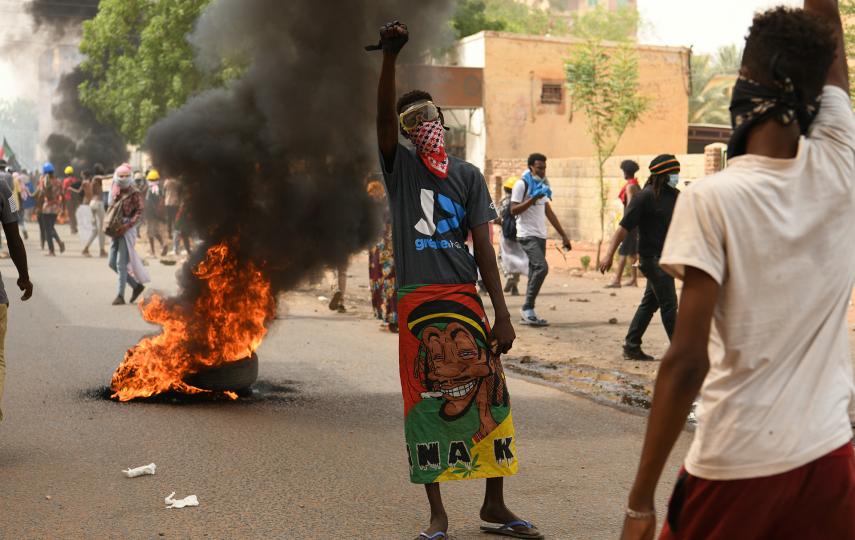Long-simmering tensions between Sudan’s military and main paramilitary force have erupted into violence over the past three days, raising the spectre of civil war and piling hardship onto communities where there are already high levels of humanitarian need.
Almost 100 civilians – three of them aid workers – have been killed amid airstrikes and clashes that have trapped millions of people inside their homes, forced the World Food Programme to halt distributions, and prevented health workers from reaching hospitals.
The nationwide fighting has quickly reached parts of the country with pre-existing conflicts involving rebel groups and militias. Many fear interventions by these groups could turn the current intra-military power struggle into a much broader conflagration.
This could have a disastrous humanitarian impact on one of Africa’s largest countries. Needs are already at record levels across the nation, with some 15.8 million people – roughly a third of the population – requiring relief this year.
The fighting was triggered by plans to integrate the paramilitary Rapid Support Forces into the army. The army wanted to merge with the RSF in two years, while the RSF – which has up to 100,000 fighters and enjoys the fruits of its autonomy – wanted longer.
Still, the rapid escalation and hardline rhetoric of the leaders of both sides reflect deeper political and social divisions within Sudan and suggest the protagonists are preparing for a protracted conflict – one long predicted by analysts and civil society groups.
Sudan’s humanitarian situation has been worsening since 2021, when the army and the RSF jointly toppled a military-civilian power-sharing government. That administration was supposed to steer Sudan to elections after the 2019 fall of dictator Omar al-Bashir.
The economy spiralled after the coup and hunger soared. Meanwhile, violent conflicts, often linked to the turbulent transition process, uprooted thousands in Sudan’s peripheral areas – Blue Nile, Darfur, Port Sudan, and South Kordofan, among them.
Though the heaviest of the current fighting has centred on the capital, Khartoum, these peripheries – long marginalised and hard to access for aid groups – could bear the brunt of what follows, according to Sudanese rights activist and writer Hala Al-Karib.
“This crisis extends way beyond Khartoum,” said Al-Karib. “Even if things eventually calm down in Khartoum, it is really going to be extremely violent in Darfur and other parts of Sudan.”
Sudan clashes: The view from Khartoum
The RSF evolved out of Darfuri Arab militias – known as the Janjaweed – created by al-Bashir in the early 2000s to crush an insurgency by non-Arab rebel groups. The militias were accused of committing genocide in the western region.
The RSF increased in power and autonomy over the past decade – sending members to fight in Yemen, and seizing lucrative gold mines back home – putting it on a collision course with the regular army, which has its own economic interests.
Despite repeated warnings of a foreseeable conflict between two heavily armed military factions, the risk of a confrontation was largely ignored, Al-Karib told The New Humanitarian.
“Everyone has buried their head in the sand and turned a blind eye to the RSF's expansion,” said Al-Karib, who is the regional director of the Strategic Initiative for Women in the Horn of Africa.
For more background context, here’s a round-up of our recent Sudan coverage. It touches on post-coup humanitarian needs, the impact of the troubled transition on Darfur, the rise of the RSF, and atrocities by the militia’s fighters.

In post-coup Sudan, hunger set to double as humanitarian needs grow
Sudan is experiencing its highest humanitarian caseload in a decade amid escalating civil conflict, erratic weather, and an economic crisis that has deepened since an October 2021 military takeover.

Sudan hunger: ‘Children are facing the threat of death’
Economic and political disorder worsened by an October 2021 coup has contributed to soaring hunger. But conflict, climate shocks, and an exploitative political economy are also driving the crisis.

‘This is my duty’: Sudan’s anti-coup protesters overcome bullets and beatings
Protesters have staged rolling demonstrations around the country, calling for an end to military rule and for a full civilian government. Here are their stories.

Guardians of the revolution: The street activists defying Sudan’s coup
Neighbourhood-based resistance committees have played a key role in Sudan’s protest movement – organising marches and debating a political strategy for the way forward.

‘Justice has to happen first’: Why Darfuris are rejecting a local reconciliation drive
The paramilitary Rapid Support Forces has been brokering peace deals in Sudan’s Darfur region. Why are so many Darfuris rejecting them?

Darfur displacement soars as peace deal falters
A recent wave of mass killings has underscored the limitations of a peace deal supposed to address the violence in Darfur, while raising fears of a wider escalation in conflict.

What’s behind the rising violence in Sudan’s Darfur?
Darfuris had hoped the worst was behind them after the 2019 ouster of Omar al-Bashir. But conflicts have escalated in the region and displacement has soared to levels unseen in years.

ICC trial brings mixed feelings for Darfur Janjaweed victims
Survivors of Darfur’s conflict have experienced a mixture of painful memories and feelings of relief as the first trial into atrocities committed in the region progresses at the International Criminal Court.





